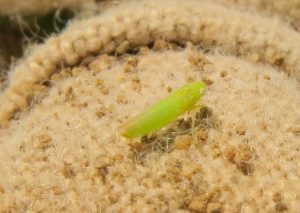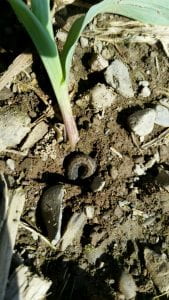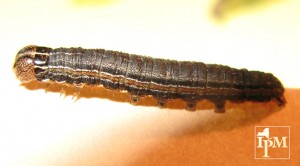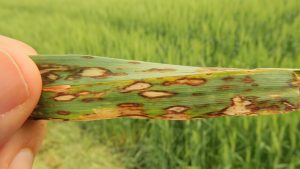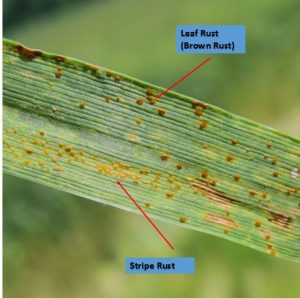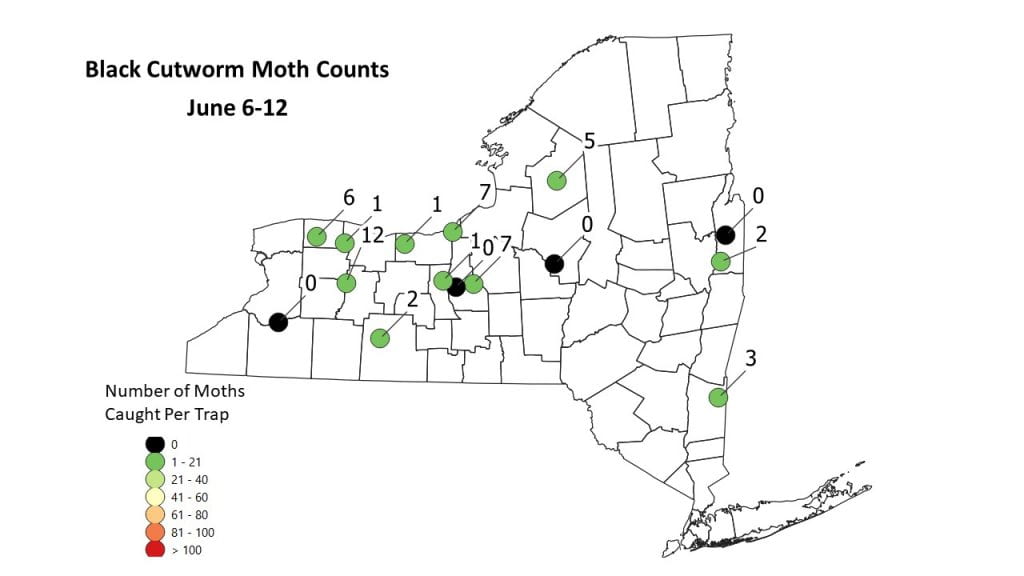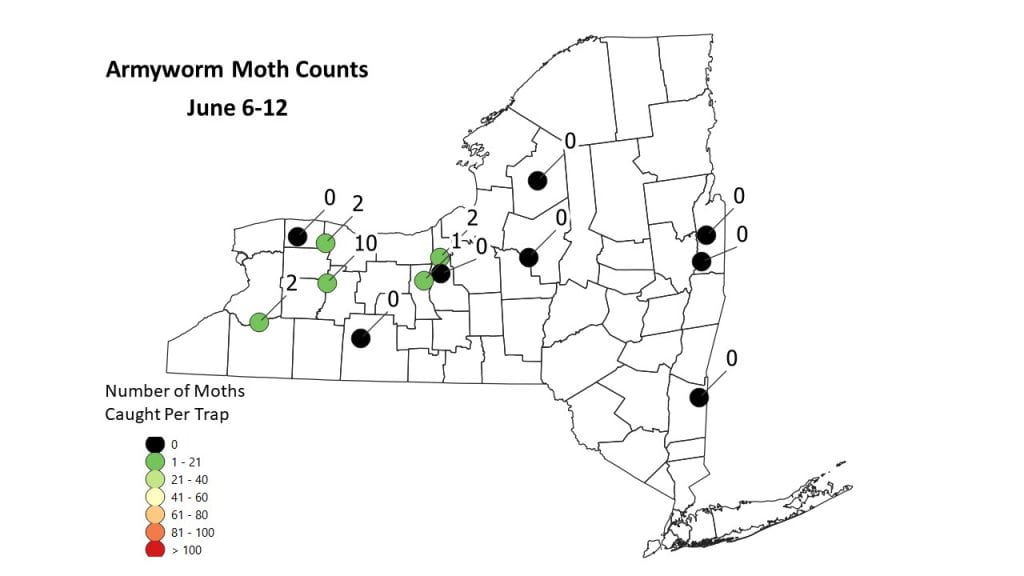NYS IPM Weekly Field Crops Pest Report
View from the Field
Soybean Aphids
Soybean aphids are increasing in populations in western NY. Be on the lookout. Soybean aphid is the only aphid that feeds on soybeans. If you look at the aphid with a hand lens, it has two dark cornicles or tailpipes extending on the rear end. Sometimes it can be confused with potato leafhopper nymphs. For more information, please view the following publication:
A Visual Guide to Counting Soybean Aphids
Potato Leafhopper
Potato leafhopper (PLH) in alfalfa are on the rise. There were a few alfalfa fields over threshold in western NY. It is best to start scouting now to monitor the increase of the population over the summer. When fields start having potato leafhopper nymphs with warm weather is when there is potential for damage. Be ahead of the population and avoid damage by scouting. For more information on thresholds and management, view the following video:
IPM for Potato Leafhopper on Alfalfa
Black Cutworm
There are some reports of black cutworm being over threshold in Western NY. The flights of black cutworm were low this last week. Check the degree-day table below to know when the larvae will be feeding in your area. NYS IPM Black Cutworm Short Video
True Armyworm
We have been monitoring for true armyworm this spring and early summer. The flights have been very low at this point. We are going to continue to monitor this pest over the next month as an extra precaution. Some years we had infestations in late July and August that were unexpected.
Leaf Rust and Scald on Barley
Dr. Gary Bergstrom (Extension Field Crops Plant Pathologist) reports scald and leaf rust on barley. For more information:
Identifying Rust Diseases of Wheat and Barley
Barley Scald- University of Maine
Japanese beetles
Mike Stanyard (CCE Team NW NY) reports the first sightings of Japanese beetles. Japanese beetles can be an occasional problem in soybeans and feeding on early corn silts. For more information:
Japanese Beetle in Corn and Soybean-Iowa State University.
Slugs
Mike Stanyard (CCE Team NW NY) reports extensive slug damage in soybeans. For more information:
Wireworm
Mike Hunter (CCE Team Northern NY) reports extensive damage to seeded corn. Wireworm will feed on seed and the roots of newly planted corn. For more information:
Alfalfa Weevil
There are reports of some economic damage by alfalfa weevil this last week. The majority of feeding has stopped because they have pupated. This means they will not be an issue until next season.
Black Cutworm Flight Map
June 6-12
True Armyworm Flight Map
June 6-12
Black Cutworm Degree-Days by Location of Intense Catches
6/22/2021
| Location for Intense Catches |
Black Cutworm Degree Days (Base 50) |
Life Stage |
|
Washington County Easton 5/2/21 18 moths caught |
640 |
Pupation-Feeding Stopped for this Flight |
|
Lewis County Lowville 5/9/21 37 moths caught |
601 |
6th Instar-Cutting Plants |
|
Lewis County Lowville 5/16/21 35 moths caught |
585 |
6th Instar-Cutting Plants |
|
Washington County Argyle 5/13/21 23 Moths caught |
588 |
6th Instar-Cutting Plants |
|
Wyoming County Castile May 20 68 Moths caught |
554
|
6th Instar-Cutting Plants |
|
Livingston County Pavilion May 20 34 moths caught |
589 |
6th Instar-Cutting Plants |
|
Orleans County Knowlesville May 20 20 moths caught |
556 |
6th Instar-Cutting Plants |
|
Lewis County Lowville 5/24/21 51 moths caught |
452 |
6th Instar-Cutting Plants |
|
Washington County Argyle 5/30/21 29 moths caught |
391 |
5th Instar-Cutting Plants |
|
Seneca County Stanley 5/9/21 83 moths caught |
647 |
Pupation-Feeding Stopped for this Flight |
|
Seneca County Stanley 5/23/21 54 moths caught |
514 |
6th Instar-Cutting Plants |
|
Oneida County Westmoreland 5/16/21 26 Moths Caught |
600 |
6th Instar-Cutting Plants |
|
Cayuga County Sterling 5/23/21 40 Moths Caught |
470 |
6th Instar-Cutting Plants |
|
Onondaga County Skaneateles 5/23/21 36 Moths Caught |
496 |
6th Instar-Cutting Plants |
|
Cayuga County Springport 5/23/21 19 Moths Caught |
514 |
6th Instar-Cutting Plants |
|
Wyoming County Castile 5/23/21 46 Moths Caught |
490 |
6th Instar-Cutting Plants |
|
Livingston County Pavilion 5/23/21 31 Moths Caught |
547 |
6th Instar-Cutting Plants |
|
Wyoming County Castile 5/30/21 44 Moths Caught |
408 |
5th Instar-Cutting Plants |
|
Livingston County Pavilion 5/30/21 3 Moths Caught |
462 |
6th Instar-Cutting Plants |
|
Lewis County Lowville 5/30/21 17 moths caught |
399 |
5th Instar-Cutting Plants |
*Intense Catch is over 15 moths in a week.
True Armyworm Degree-Days by Location of Intense Catches
6/12/2021
| *Location for Intense Catches |
True Armyworm (Base 50) |
Life Stage |
|
Livingston County Pavilion 5/7/21 17 Moths Caught |
703 |
Leaf Feeding |
*Intense Catch is over 15 moths in a week.
Clipboard Checklist
Keith Waldron, NYS IPM
General
*Walk fields to check general field condition, weed issues
*Watch for crop maturity, stand assessments, weed escapes, nutrient deficiencies, lodging issues
Alfalfa:
*Evaluate established legume stands for approximate days until harvest
*Monitor potato leafhopper, foliar, systemic and crown rot diseases.
*Monitor new seedings for potato leafhopper, pythium blight, phytopthora root rot.
Small Grains:
*Monitor small grains for signs of Fusarium Head Blight, foliar diseases
*Monitor grain fields for growth stage, disease issues, grain maturity, harvest timing
*Record diseases present, location and types of weed escapes
Corn:
*Monitor for mid-season corn pests including European corn borer, corn rootworm, western bean cutworm, slugs, foliar diseases such as northern corn leaf blight and gray leaf spot, weed issues, nutrient deficiencies, vertebrate damage.
Soybeans:
*Monitor for crop growth stage, soybean aphid, defoliators, foliar diseases, white mold, weed issues, vertebrate damage
Pastures:
*Check water sources, mend fences as needed.
*Check crop growth, clip pastures between grazing as needed
*Monitor for invasive species, plants harmful to livestock
*Review/Plan rotations
Equipment:
*Carry appropriate / necessary NYS DEC and EPA documents as needed: (pesticide applicators license, pesticide labels, MSDS sheets, etc.)
Storage:
* Check stored grain bins for temperature, moisture and signs of mold and insects. Aerate, core, transfer grain or treat as necessary
* Clean and disinfect empty storage bins in preparation for grain harvest
*Check forage allocation and anticipate feed program adjustments as forages from previous year are used up
*Mow around storage bins and facility to minimize pest hiding places
Dairy Cattle Barn Fly Management:
*Monitor animals and barn area for house fly, stable fly and other pest management needs including presence of rodents and birds.
*Check facilities for favorable fly breeding conditions: (organic matter + moisture): leaks in watering systems, roof gutters for leaks and potential overspill, drainage,
*Sanitation, sanitation, sanitation – clean animal resting areas, feed troughs, minimize source of moist organic matter i.e. fly breeding areas in barn and in adjacent animal loafing yard
* Continue fly monitoring: install “3X5″ index card fly speck monitoring cards throughout barn
*Use, replenish, replace fly management materials: sticky fly tapes/ribbons, insecticide baits, natural enemies (parasitoids), fly population monitoring (3 x 5) spot cards
*Consider purchase and release of Muscidifurax raptor and/or M. raptorellus natural enemies of house and stable fly pupae.
Dairy Cattle on Pasture:
*Monitor animals for presence of face flies, horn flies and stable flies. Action guidelines: face flies (average 10 per animal face), horn flies (average 50 / dairy per animal side, 200 / beef cattle per animal side), stable flies average 10 per animal (all four legs)
*Check feed bunk / water source locations for signs of stable fly breeding (moist undisturbed organic matter – spilled feed, round bales, etc.), minimize source of moist organic matter i.e. fly breeding areas in barn and in adjacent animal exercise yard.
*Check pasture for forage quality / quantity, rotate as appropriate
*Check pasture for vegetation poisonous to livestock
*Consider use of pasture fly traps to help reduce deer, horse and stable fly populations


